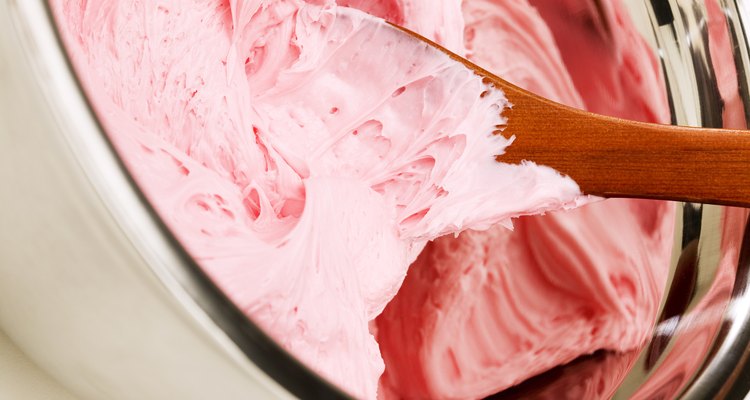
Jupiterimages/liquidlibrary/Getty Images
Constructing a surfboard-shaped cake is nearly as straightforward as assembling a standard layer cake. The main difference between the two cakes is that a traditional layer cake comprises stacked layers while a surfboard cake comprises two or more sections joined side by side. Use a template as a guide as you trim a rectangle in to the pointed oblong shape of a surfboard. It also helps to keep a photo or illustration of a surfboard near you to inspire you and keep you on track while you work.
Cover a baking sheet or cutting board with parchment paper. Use a board that will support the entire cake. Or, use a ready-made cake board.
Arrange square or rectangular single-layer cakes side by side to create a rectangle that is at least as wide and long as you want the surfboard cake to be. For example, place two 8-inch-square cakes side by side -- yielding an 8- by 16-inch rectangle -- to make a 6- by 14-inch surfboard cake. One 9- by 13-inch cake would also be appropriate if you are making a 6- by 14-inch surfboard.
Draw or print a surfboard template the same size you want the cake to be. You may need to tape a few pieces of paper together to create the full template. Cut the template out so it doesn’t have a border.
Center the template on the cakes. Secure it by inserting toothpicks through the template into the cakes, if you need to.
Trim around the edge of the template with a sharp knife. Discard the template and cake trimmings.
Gently separate the cakes 2 to 3 inches. Apply a generous layer of frosting to the sides of the cakes that touch when the surfboard shape is intact. Slide the sections back together.
Apply a light coat of frosting to the top and sides of the bare surfboard cake. Use a frosting spatula or broad, rounded knife to spread the frosting. This is the crumb coat, which traps the loose crumbs and acts as an adhesive for the fondant.
Dust your work surface and a rolling pin generously with cornstarch. Place a piece of colored fondant on the dusted surface. Roll the fondant into a 1/8-inch-thick disc that is at least 6 inches wider and 6 inches longer than the surfboard. For example, roll a fondant disc that is 12 by 20 inches to cover a 6- by 14-inch surfboard.
Transfer the fondant disc gently onto the cake. Drag a fondant smoother gently over the top of the cake in a straight line from one edge to another. Apply enough pressure to smooth the fondant without making any indentations or tearing the fondant.
Smooth down the sides of the cake. Trim around the base of the cake with the tip of a sharp knife to remove excess fondant.
Roll a small, thick disc of fondant. Cut a fin shape from the fondant with a knife. Follow a template, if you need to, or cut it freehand.
Apply a line of frosting along the long, straight edge of the fin. Place the fin frosting-side down on the center of the surfboard near the pointed end.
Pipe frosting decorations or cut decorations from rolled fondant, such as stripes, chevrons and numbers. Single-color tropical motifs, such as a sun or palm tree, are also appropriate.
Decorate the cake board around the surfboard, if you wish, creating ocean waves by spreading generous dollops of blue frosting in overlapping crescent shapes on the cake board. Make edible sand by blending dry light-colored cookies in to a fine crumb, then affix the faux sand to your cake board with a generous layer of frosting.
Related Articles
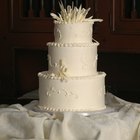
How to Decorate Fake Cakes
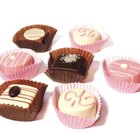
How to Make Petit Fours

How to Make a Cruise Ship-Shaped Cake

How to Make a Bible-Shaped Cake

How to Make a Guitar Out of Cupcakes

How to Make a Bible Cake With Fondant ...

How to Make a Homemade Horse ...

How to Make Mini Cakes
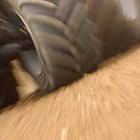
How to Make a Monster Truck Birthday ...
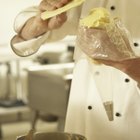
How to Make a Hogwarts Castle Cake

How to Make a Number Six Cake
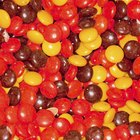
How to Make a Frog Cake

How to Make Fondant Camouflage
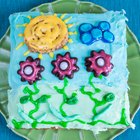
How to Make Plaques for Cakes

How to Make a Cake Board

How to Make a Fake (Faux) Cake
Freezing a Cake With Buttercream ...
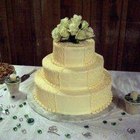
How to Make a 3-Tier Wedding Cake
How to Measure Fondant
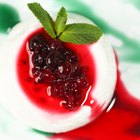
How to Cook Mini Cheesecakes in Ramekins
References
Writer Bio
Lamar Grey has been writing about cooking and food culture since 2010. He has ghostwritten eight cookbooks. Grey entered the culinary industry in 2003 as a prep cook in a full-service restaurant. He subsequently served as a baker and head cook on three award-winning kitchen staffs.
Photo Credits
Jupiterimages/liquidlibrary/Getty Images